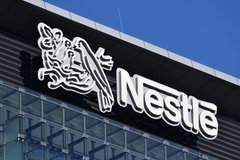
- Industry news
Industry news
- Category news
Category news
- Reports
- Key trends
- Multimedia
- Journal
- Events
- Suppliers
- Home
- Industry news
Industry news
- Category news
Category news
- Reports
- Key trends
- Multimedia
- Events
- Suppliers
Cargill executive on future-proofing the cocoa sector while delivering real climate impact

Cargill’s latest cocoa supply chain investments represent a “fundamental shift” in how the company thinks about supply chain infrastructure, focusing on building systems that not only move cocoa but also reduce emissions, cut waste, and actively contribute to decarbonization targets.
Emiel van Dijk, managing director of Cocoa & Chocolate Europe and West Africa, speaks to Food Ingredients First about the overhaul, which improves sustainability practices from cocoa-origin countries in West Africa to processing hubs in Europe.
“In the Netherlands, for example, cocoa now travels from the port to our factory in Zaandam on the world’s first fully electric pusher boats — powered by wind energy through our partnership with Vattenfall’s Windpark Hanze.”

“We are also installing a biomass boiler in Amsterdam that runs on cocoa shells generated during processing. Together with Windpark Hanze, the CO2 emissions reduction reaches more than 31,000 metric tons per year, representing a reduction of site CO2 emissions of up to 90%.”
“These are not standalone projects. They’re part of a larger design that integrates sustainability into every stage of the cocoa journey — from solar-powered production at origin, to BIO LNG trucking and semi-automated warehousing in Europe. It is all about future-proofing the cocoa sector while delivering real climate impact today.”
Scaling climate action without compromise
Ensuring operational efficiency is even more important amid constantly challenging market dynamics in the cocoa sector, which has been rocked by escalating prices and availability problems.
“We’ve seen cocoa prices reach record highs in recent months, driven by a combination of reduced yields, crop disease pressure, and climate-related challenges in origin countries.”
“At a time when cocoa prices are under the spotlight, ensuring operational efficiency and reducing energy risk — like through biomass and renewable-powered infrastructure — also helps stabilize costs further down the line. It’s not just about reacting to today’s prices but preparing for a more unpredictable future,” Van Dijk adds.
Ensuring operational efficiency is even more important amid constantly challenging market dynamics in the cocoa sector.
Collaboration is crucial
There is a growing recognition that sustainability must be built into the core of supply chain design, especially in cocoa, which is both energy- and transport-intensive.
Van Dijk stresses that circularity and clean energy are essential to achieving that.
“We’ve invested in turning cocoa shells into fuel, reducing the use of single-use packaging through ISO tank transport, and moving products with electric barges and biofuel trucks. But these kinds of efforts need to be scaled up across the industry.”
“We also need to be realistic. Moving toward zero waste and renewable energy isn’t always straightforward, particularly in regions where infrastructure is still developing.”
“That’s why collaboration is key — between businesses, governments, logistics providers, and energy partners. The more we share learnings and raise the bar together, the faster we can transition the industry.”
Cargill’s broader climate goals
Cargill aims to reduce absolute greenhouse gas emissions from its operations by 10% by 2025. These cocoa supply chain investments embed this target and demonstrate how the company continues to build sustainability at scale despite facing complex climate-centric challenges.
“Climate change and food security are inextricably linked. As weather patterns shift and extreme events become more frequent, the global food system is being tested in new ways. While it has proven resilient, continued progress will depend on efforts to both reduce emissions and build long-term resilience.”
“We’re taking proactive steps to meet these complex challenges head-on. Through our global reach and partnerships, we’re advancing practical, commercially-viable solutions that lower emissions, support more sustainable practices, and strengthen the resilience of the global food system.”
“In fact, as of 2023, Cargill reduced emissions from our operations by 15.8% — exceeding our goal to reduce our absolute operational greenhouse gas emissions by 10% by 2025. We have continued to build on that progress year over year,” Van Dijk concludes.










